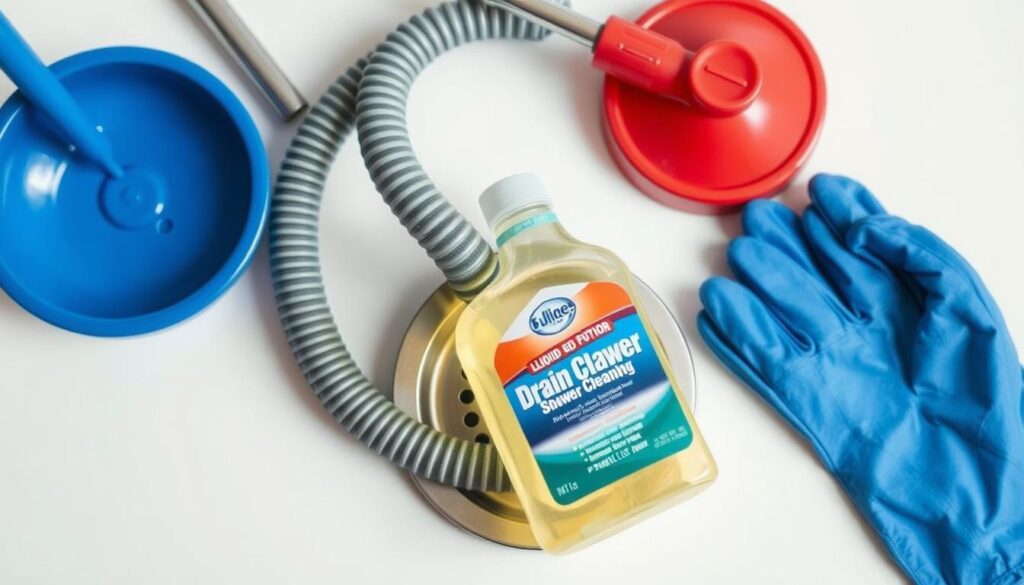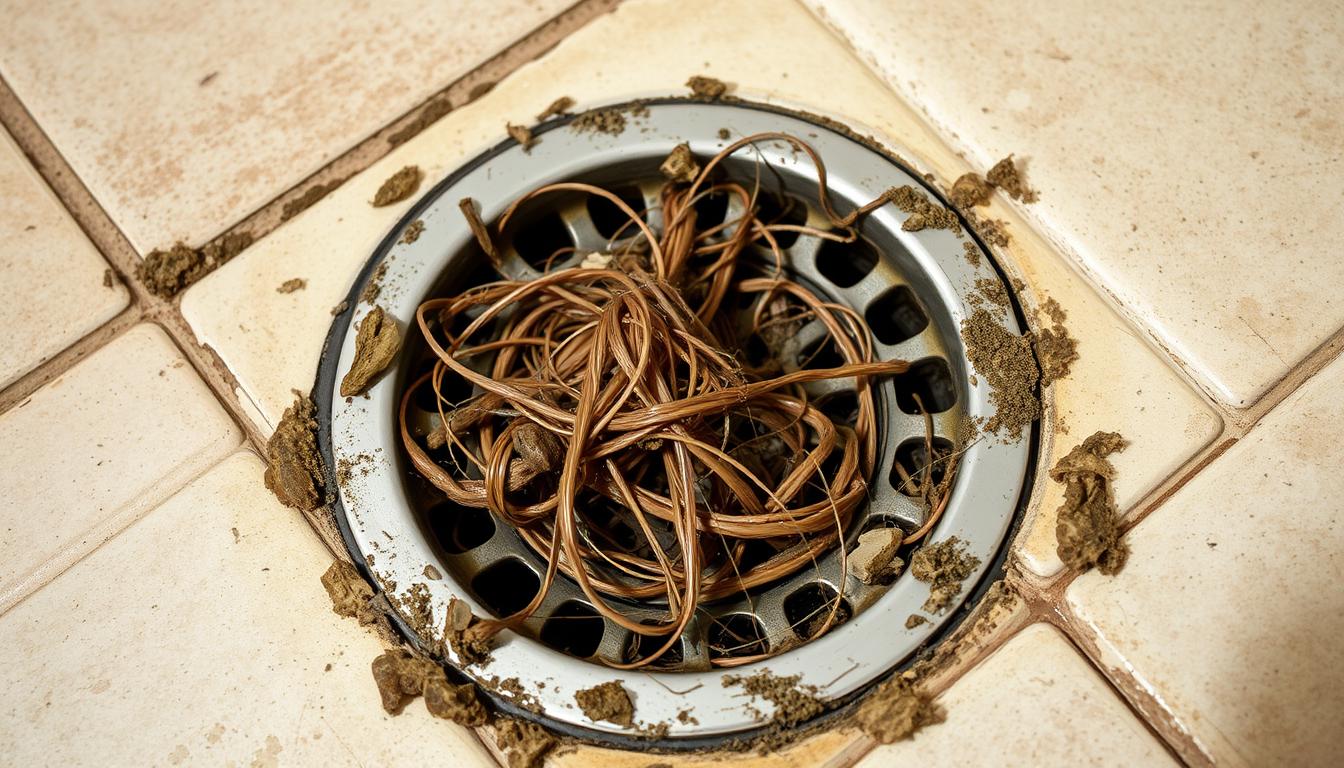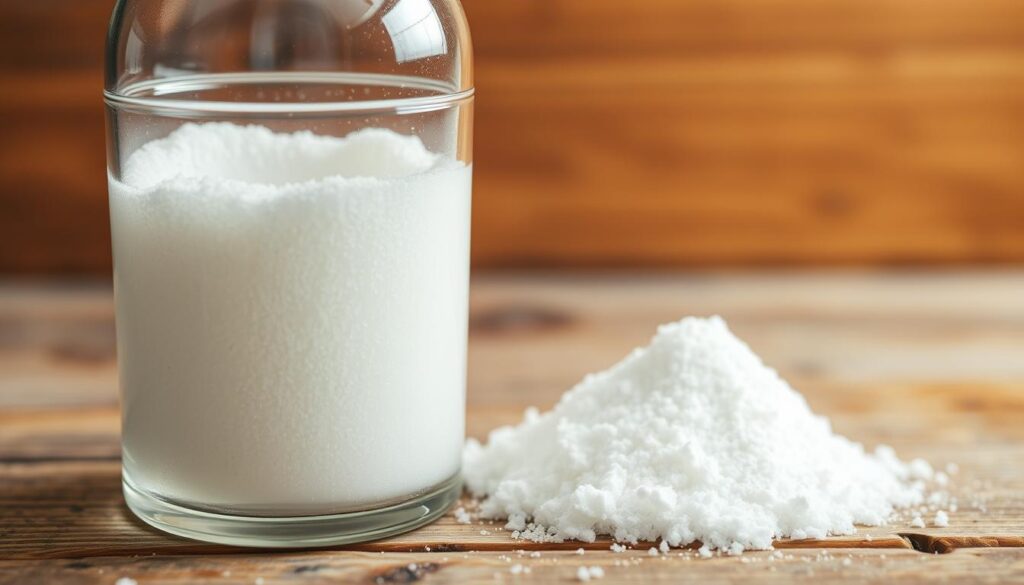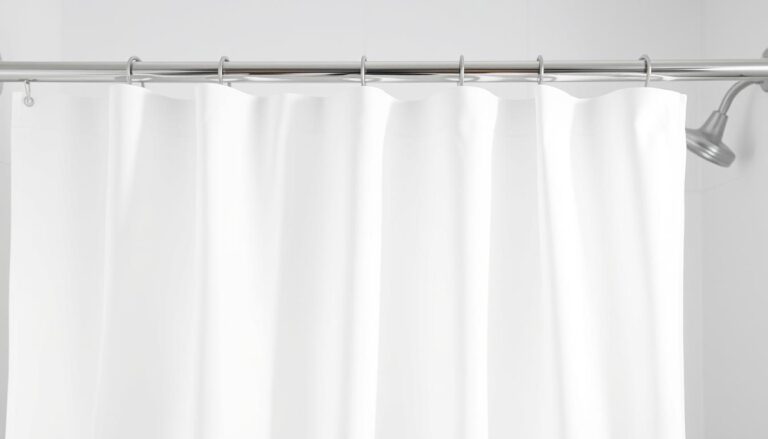how to unclog shower drain
Table of Contents
How to Unclog Shower Drain
A clogged shower drain can ruin your relaxing shower time. Signs include standing water, slow flow, and bad smells. Knowing how to fix it can save you time, money, and prevent water damage.
Most clogs come from hair, soap scum, and other debris. About 80% of clogs are from hair. Knowing the causes and having the right tools can help you fix it easily.
This guide will show you how to deal with a clogged shower drain. You’ll learn simple DIY fixes and more advanced methods. Whether it’s a small blockage or a tough clog, you’ll find steps to fix it.
Key Takeaways
- Hair and soap scum are primary causes of shower drain clogs
- Regular maintenance can prevent most clogs
- DIY methods like baking soda and vinegar can clear minor blockages
- A drain snake is effective for removing hair clogs
- Using a drain cover can reduce clogging incidents by nearly 50%
- Professional help may be needed for persistent or deep clogs
Understanding Common Causes of Shower Drain Clogs
Shower drain clogs are a common problem, affecting about 60% of homeowners yearly. Knowing what causes these clogs can help you avoid them. This way, you can keep your drain clean and working well.
Hair and Soap Scum Buildup
Hair is the main reason for shower drain clogs, making up nearly 90% of the blockage. When hair mixes with soap scum, it creates a sticky mess. This mess can shrink pipe diameter by up to 50% over time.
Mineral Deposits and Hard Water Effects
In places with hard water, mineral deposits build up at a rate of 5-10% each year. These deposits cause limescale buildup, which narrows pipes and makes water flow harder. Flushing with hot water daily can cut mineral buildup by up to 30%.
Product Residue Accumulation
Soap residue and other shower products can lead to sticky clogs over time. This residue, along with hair and mineral deposits, forms a hard blockage. Using eco-friendly bacterial drain cleaners monthly can cut organic buildup by 90%, keeping your pipes clean.
By knowing these common causes, you can take steps to prevent clogs. Regular cleaning and maintenance can lower the risk of severe blockages by 50%. This saves you time and money on plumbing problems.
Essential Tools and Materials for Drain Unclogging
Fixing a clogged shower drain needs the right tools and products. Let’s look at what you’ll need to make your drain work again.
Basic Hand Tools Required
Begin with simple tools like pliers and a drain snake. Pliers help clear surface debris, while a drain snake tackles deeper clogs. A Vastar Drain Snake, which extends 20 inches, is perfect for manual removal. Also, a flashlight is essential for a good look at the drain.
Chemical and Natural Cleaning Solutions
Drain cleaning products vary in type. Drano Max Gel Liquid Clog Remover, priced around $9, works fast on minor clogs. For a green option, try baking soda and vinegar. This combo is great for about half of household clogs.

Safety Equipment Needed
Always prioritize safety. Wear rubber gloves to protect your hands from harsh chemicals and debris. Safety goggles keep your eyes safe from splashes. Make sure your bathroom is well-ventilated when using chemical cleaners to avoid inhaling fumes.
- Rubber gloves
- Safety goggles
- Face mask (for chemical use)
- Old towels or rags
With these tools and materials, you’re set to handle most shower drain clogs safely and effectively. Regular maintenance can cut clog frequency by up to 50% if done every six months.
How to Unclog Shower Drain: Step-by-Step Guide
Unclogging shower drains is a common task at home. Hair is the main culprit, causing 90% of clogs. Knowing how to clear clogged drains is essential. This guide will help you unclog your shower drain effectively.
Begin by taking off the drain cover. Use pliers if it’s stuck. After removing it, look for any debris. Hair and soap scum can make clogs hard to remove. Use your fingers or tweezers to clear out any visible blockages.
If the clog is still there, try using a plunger. Fill the shower with a few inches of water and plunge hard. This can clear up to 70% of minor clogs. For tougher clogs, a drain snake or auger can help about 90% of the time.
- Remove drain cover
- Clear visible debris
- Use a plunger
- Try a drain snake
- Apply natural remedies
For a natural fix, pour boiling water down the drain, then mix baking soda and vinegar. This method can clear 70% of minor clogs in about 30 minutes. If these steps don’t work, it’s time to call a plumber.
Preventing clogs is important for shower drain maintenance. A mesh screen can cut hair blockages by 80%. Regular cleaning can also extend your drain’s life by 50%. By following these steps, you’ll be ready to handle clogged shower drains and keep your plumbing system running smoothly.
Manual Removal Methods for Surface Clogs
Dealing with a clogged shower drain? You’re not alone. About 80% of homeowners face this issue at some point. Let’s explore simple, hands-on techniques for clearing clogged drains.
Using Pliers and Tweezers
For surface clogs, pliers or tweezers can be effective hair clog removers. Put on rubber gloves and gently pull out visible debris. This method works best for clogs near the drain opening. Be careful not to push the clog deeper into the pipe.
Drain Cover Removal Techniques
To access deeper clogs, you might need to remove the drain cover. Here’s how:
- Unscrew the cover if it has visible screws
- For pop-up covers, twist and lift
- Some covers may require a special tool for removal
Once removed, clean the cover thoroughly. You’ll often find hair and soap scum buildup here. This simple maintenance can prevent future clogs.
Remember, these methods work best for minor blockages. If you’re dealing with a stubborn clog, you might need to try other drain clog removal techniques or call a professional. Regular drain cleaning can save you from costly plumbing repairs down the line.
Natural Cleaning Solutions and DIY Methods
Want a natural way to clear your drain? The baking soda and vinegar method is a great choice. It’s good for 90% of minor clogs. Plus, it can save you up to $100 a year on plumbing costs.
Here’s how to use this natural cleaning trick:
- Pour 1/2 cup of baking soda down the drain
- Follow with 1/2 cup of white vinegar
- Cover the drain and let it sit for an hour
- Rinse with boiling water
- Repeat if necessary
This DIY method is not only effective but also safe for your pipes. Unlike harsh chemicals, baking soda and vinegar are gentle yet powerful. They dissolve dirt, grime, and hair without harming your plumbing.
For the best results, use this natural solution monthly. Regular use can stop stubborn clogs and keep your shower drain working well. Remember, a simple hair trap can cut clog chances by 80%.
Using Chemical Drain Cleaners Effectively
When natural methods don’t work, a shower drain cleaner might be next. Chemical drain cleaners can be very effective against clogs. Over 70% of homeowners use them first. Here’s how to use them safely and well.
Types of Chemical Cleaners
Drain cleaning products vary. Caustic cleaners break down fats and grease at a molecular level. Acidic cleaners, with sulfuric or hydrochloric acid, heat up to dissolve clogs. Enzymatic cleaners use bacteria to break down organic matter.
Safety Precautions and Application
Using a drain cleaner requires safety. Always wear gloves and eye protection. Pour 1 to 3 tablespoons of the cleaner into the drain, as directed. Let it sit for up to 30 minutes before flushing with hot water. Never mix different cleaners, as it can create toxic hydrogen gas.
When to Avoid Chemical Solutions
Chemical drain cleaners aren’t always the best choice. They can damage old metal pipes, increasing corrosion risks by 40%. If you have a septic system, avoid these cleaners as they can harm essential bacteria. For stubborn clogs or if you’re unsure, it’s best to call a professional plumber.
Remember, while drain cleaners can be effective, they’re not a long-term solution. Regular maintenance, like weekly hot water flushes, can prevent most clogs and reduce the need for harsh chemicals.
Advanced Techniques Using Plumbing Tools
When simple methods don’t work, it’s time to bring out the big guns. Advanced tools can tackle stubborn clogs and keep your shower running smoothly.
Proper Plunger Usage
A plunger is a great tool for unclogging shower drains. First, fill the shower with a few inches of water. Next, place the plunger over the drain, making sure it’s sealed.
Then, push down and pull up quickly several times. This creates suction that can dislodge the clog. If it doesn’t work, you might need to do it a few more times.
Drain Snake Operation
A drain snake is perfect for tackling deeper clogs. Start by inserting the snake into the drain opening. Then, turn the handle to guide it through the pipe.
When you feel resistance, you’ve found the blockage. Rotate the snake to break up or grab the clog. Slowly pull it out, removing debris as you go.
Auger Application Methods
An auger is like a drain snake but more powerful. Feed the auger cable into the drain until you hit resistance. Turn the handle to bore through the clog.
The auger’s spiral end will break up or retrieve the blockage. Pull it out carefully to remove the debris.
Remember, these tools need care to avoid damaging pipes. If you’re unsure or the clog persists, it’s best to call a professional plumber. They have the skills and tools to handle tough blockages safely.
Dealing with Stubborn Clogs and Deep Blockages
Stubborn clogs are hard to get rid of with simple methods. Start with a plunger. Fill the shower with enough water to cover the plunger head. Make a tight seal and use quick, forceful motions to create suction. This method works in about 60% of cases, helping to loosen the blockage.
If plunging doesn’t work, try a drain snake or auger. These tools can reach deeper into the pipe, tackling clogs further down. Drain snakes have an 80% success rate for clearing stubborn blockages. Insert the snake into the drain, turning the handle to guide it through the pipe until you feel resistance. Then, rotate and push to break up the clog.
For persistent issues, combine methods. Pour a mixture of 1/3 cup baking soda and 1/3 cup vinegar down the drain. Let it sit for 20-60 minutes, then flush with hot water. This natural solution clears mild to moderate clogs 70% of the time. If the blockage remains, repeat the process or try a chemical cleaner as a last resort.
Remember, recurring clogs often indicate a deeper issue. If you’ve tried multiple methods for unclogging shower drain without success, it’s time to call a professional plumber. Experts recommend seeking professional help after failed DIY attempts to prevent serious plumbing problems down the line.
Preventing Future Shower Drain Clogs
Keeping your shower drain clear is simpler than you think. By taking a few easy steps, you can avoid headaches and save money. Let’s look at some ways to stop clogs and keep your drain clean.
Installing Drain Covers
Using a drain cover is a smart move to stop clogs. These covers can cut down hair-related clogs by 90%. They catch hair and other stuff before it goes down the drain, making cleaning easier.
Regular Maintenance Schedule
Make a plan to keep your drain clear. Use hot water to flush your drain once a week. This helps dissolve soap scum and grease.
Every month, mix baking soda and vinegar, then add hot water. This natural combo cleans your pipes well and cuts down on chemical use.
Best Practices for Drain Care
Here are some tips to keep your shower drain working well:
- Remove hair after each shower
- Don’t let small items like bottle caps go down the drain
- Use liquid soap to avoid scum buildup
- Think about getting a water softener to stop mineral buildup
By following these tips, you can cut clog frequency by 50%. Remember, regular care helps avoid expensive plumbing fixes. If clogs keep happening, call a pro plumber for a deep clean.
When to Call a Professional Plumber
You’ve tried every trick to unclog your shower, but it still won’t drain. It’s time to call a professional plumber. They can handle tough clogs that DIY methods can’t and prevent future problems.
Signs of Serious Plumbing Issues
Look out for these signs that mean you need a pro:
- Multiple clogged drains in your home
- Foul odors coming from drains
- Gurgling sounds in pipes
- Water backing up in sinks or tubs
- Frequent toilet overflows
Did you know 15% of cases with many clogged drains might mean a big problem with the main sewer line? If you see any of these signs, get help fast to clear clogged drains.
Cost Considerations
Professional plumbing services cost money, but they can save you more in the long run. Here’s why:
- Prevent water damage: 20% of annual plumbing insurance claims relate to water damage
- Avoid health risks: 35% of homes with ongoing drainage problems face mold growth
- Ensure thorough cleaning: 65% of annual drain cleaning services use advanced techniques like hydro-jetting
Remember, 75% of plumbing pros say regular maintenance stops small problems from getting big. Spending on professional drain cleaning can save your home and money from expensive fixes later.
Conclusion
Learning to unclog your shower drain is a skill every homeowner should have. You now know simple DIY tricks and advanced methods to handle different clogs. Keeping your drain clean is the best way to avoid clogs.
Try using baking soda and vinegar for mild clogs. Let it sit for 1-2 hours for the best results. For stubborn clogs, you might need chemical cleaners or a plumber. Plumbers use tools like hydro-jetting and cameras to fix tough problems.
It’s important to prevent clogs, especially since showers use a lot of water. With several showers a day, your drain faces a lot of hair, soap, and other debris. By following these tips, you can keep your shower drain clear and avoid expensive plumbing problems.








